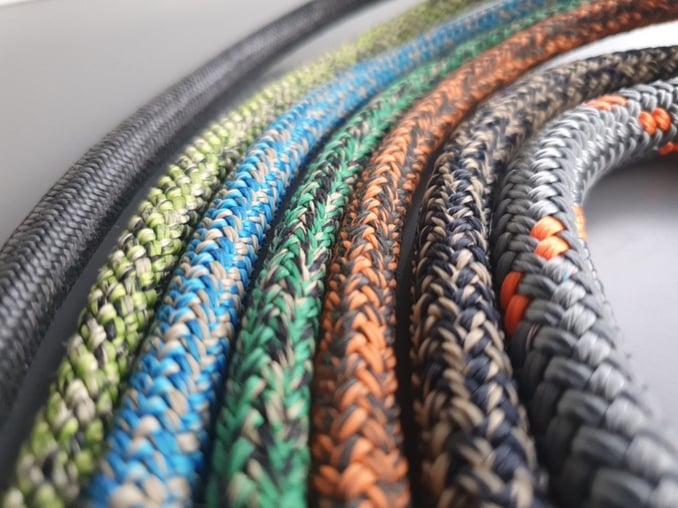
All sailing boats need ropes. But what is required of a rope varies greatly depending on the application. A vang purchase system demands different characteristics to a sheet, just as a halyard on a cruising boat can differ greatly to that on a grand prix racing yacht. Typically we don’t need to worry about the details too much as manufacturers tend to target their product lines: ‘cruising sheet’, ‘performance halyard’ etc. But what really differentiates these ropes on a technical level and which materials are responsible for providing the various characteristics? In this blog with give a brief overview of some of the fibres most commonly found in modern rope covers.
A quick note on cores
A double braid rope has a core and a cover. The core is what gives the rope its strength and stretch properties. The cover determines the handling characteristics of the rope and its performance in jammers, on winches etc. Core materials are most commonly one of two types: UHMWPE (such as Dyneema®) and Polyester. Polyester is the more affordable option and used widely on cruising boats. Most Polyester cored ropes also have a simple Polyester cover. It is only once we look at higher performance ropes with UHMWPE cores that we start to see diversity in cover materials as will be the focus of this blog.
For more info on cores click here
Cover materials
Most performance yacht ropes feature a blend of materials in the cover to achieve a combination of characteristics for a specific application. The following table summaries some of the most common fibres used:

Polyester
Polyester (PET) is the workhorse of modern rope covers. A pure polyester braided cover can be slippery when new but becomes grippy after a few uses and offers good all-round properties, making it the go-to for cruisers and cruiser/racers. The drawback of polyester is its relatively low melting point. A polyester cover can easily start to melt during a big ease of a highly loaded spinnaker sheet due to the heat generated by friction. Polyester is often used as the base material for blending in other fibres.
Products with polyester cover:
Technora®
The Technora branded aramid fibre is renowned for excellent heat resistance making ideal for high-speed lines. Technora is susceptible to UV degradation but is a fitting counterpart to polyester. Technora/polyester covers are used widely on performance cruisers and racing boats. This makes an all-round performance rope suitable for sheets, halyards and control lines.
Ropes with polyester/Technora covers:
Cordura®
Cordura is a Nylon based fibre which is specially treated to create a rough texture. With similar properties to polyester, Cordura offers excellent grip from first use without needing to wear in. Cordura is often blended into high performance lines to increase their grip properties.
Powerhalyard features Cordura blended into the cover
Dyneema®
Famous for being super lightweight and stronger than steel, Dyneema and other UHMWPE fibres are most commonly used as core materials. However, Dyneema also has an application as a cover material offering low friction, good UV stability and abrasion resistance. Pure Dyneema covers can be added to exposed sheet and halyard ends to reduce friction and wear through blocks/sheaves. Dyneema is also blended with other materials to add wear resistance and UV stability. Dyneema has a limited resistance to temperature.
Superswift contains Dyneema in the cover for excellent abrasion resistance
Zylon®
Zylon is a brand name for PBO and is often used as a core material for rigging cables due to its high strength characteristics and stability under static load. PBO is used pure or as a blend in braided rope covers offering heat resistance and smooth control on a winch. Typical applications include runner tails on grand prix race yachts. The lifespan of the material is relatively short due to high UV degradation.
Vectran®
Vectran is spun from liquid crystal polymer and is one of the highest strength and lowest elongation fibres after PBO. Vectran offers good grip and resistance to abrasion and heat. Vectran is typically blended with polyester or polyester/Technora for high load lines, aft guys or runners. Vectran is subject to UV degradation.
Kevlar®
Kevlar is another Aramid fibre but has been somewhat superseded by Technora. Kevlar is still used in blended covers together with Polyester or Dyneema to add heat resistance.
Summary
We have summarised 7 different modern fibres commonly used in cover braids for sailing ropes. Of course many other fibres exist but these are often close relatives to those listed above, for example further aramids (like Technora and Kevlar) and a variety of UHMWPE materials (like Dyneema). Some manufacturers also produce their own brand fibres.
When choosing a new rope it’s worth having a general understanding of the different materials and their characteristics. Polyester covers are the starting point and suitable for most applications. Upgrading to a polyester/Technora blend can make a big difference for high-speed lines such as spinnaker sheets but also offer better grip and endurance for halyards and other lines.
Cordura offers superb grip at an affordable price, great for halyards.
Adding Dyneema to a cover provides excellent endurance particularly for highly loaded control lines in aggressive clutches or sheets for example on the 49er, Nacra etc.
Zylon/PBO is a specialist fibre used on high-load lines requiring good grip and precise control, such as runner tails on grand prix racing yachts or sheets on Olympic classes.
Vectran and Kevlar offer generally similar properties of heat resistance and grip. Suitable for sheets or halyards.
If you have any questions about Yacht ropes, please feel free to email us at support@upffront.com, or click the link below to see our full range of ropes:


